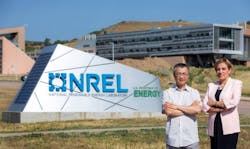DOE Selects NREL to Lead Two $19M Projects to Research LDES Degradation and Offshore Wind Modeling
The U.S. Department of Energy (DOE) Office of Science has announced $264 million in funding for 29 projects to develop clean energy solutions to achieve a net-zero-carbon economy by 2050.
The funding is part of the DOE's Energy Earthshot Initiative, which is designed to accelerate breakthroughs that create more abundant, affordable, and reliable clean solutions.
As part of this initiative, the DOE has awarded funding to the National Renewable Energy Laboratory (NREL) to lead two Energy Earthshot Research Centers (EERCs), each of which received $19 million.
The two EERCs focus on floating offshore wind modeling and degradation in electrothermal long-duration energy storage.
"The Energy Earthshot awards are incredibly exciting for the laboratory," said Johney Green, Associate Laboratory Director for the Mechanical and Thermal Engineering Sciences Directorate at NREL, which will be leading the two NREL Energy Earthshot Research Centers. "These initiatives were chosen because they are tackling some of the most challenging barriers of deploying clean energy technologies at scale."
The first NREL EERC - Floating Offshore Wind Modeling and Simulation (FLOWMAS) - will address the DOE's Floating Offshore Wind Shot to reduce the levelized cost of energy from floating offshore wind by 70% by 2035 by solving fundamental mathematical and high-performance-computing challenges to predict and understand offshore wind energy systems.
For this EERC, NREL is partnering with Lawrence Berkeley National Laboratory, Sandia National Laboratories, and Oak Ridge National Laboratory, as well as the University of California at Merced, Howard University, and the University of Minnesota.
"To reduce the levelized cost of energy, we need to have a very good understanding of the loads and dynamics of floating offshore wind turbines in an ocean environment—both at a very small scale and at a climate scale. For example, if you're planning to build a wind turbine in the ocean at some point, you want to know that that wind resource is going to exist, at least at some level, 20 years from now," said Michael Sprague, Chief Wind Computational Scientist at NREL and director of the FLOWMAS EERC.
"Right now, the models we have are sorely lacking, and our understanding of the ocean environment is lacking. In this EERC, we're planning to create new models and use high-performance computing to better understand and predict the response of floating offshore wind turbines. A key challenge will be creating new algorithms that span many scales and physics and run efficiently on modern high-performance computers," added Sprague.
This is a complex task to accomplish. Offshore wind turbines must have manageable loads when operating while being able to withstand extreme weather events, such as hurricanes. Researchers must also be able to better predict how climate change will affect wind resources in different parts of the ocean.
The second NREL EERC - Degradation Reactions in Electrothermal Energy Storage (DEGREES) - hopes to advance the fundamental understanding of the degradation mechanisms of materials for electrothermal long-duration energy storage (LDES), a critical component of a resilient, flexible, and decarbonized electric grid. LDES allows for the efficient storage of excess clean energy from renewables like wind and solar.
Unfortunately, the thermal energy storage materials available today are not capable of meeting the needs of grid-scale LDES, due in large part to degradation.
To address this challenge, NREL will partner with Brookhaven National Laboratory, Argonne National Laboratory, the University of Texas at Dallas, Georgia Institute of Technology, Auburn University, the University of Arizona, the University of Chicago, and the University of New Mexico.
Together they will work to understand degradation, learn to control it, and translate this knowledge to improve LDES. The teams will examine the instabilities of high-energy-density thermal energy storage materials by leveraging crosscutting theory, modeling, and experiments while focusing on communication and collaboration.
A major goal of the project is to develop the necessary understanding, characterization tools, and modeling capabilities to enable designers and engineers to create feasible thermal energy storage components that are cost-effective, durable, reliable, and dispatchable.
"NREL is the lab for integration. We work well together, and we aren't siloed—there is so much support here. That's one of the things that made this EERC proposal successful," said Judith Vidal, Manager of the Building Thermal Energy Science group at NREL and Director of the DEGREES EERC along with associate director Katie Jungjohann. "External partnerships have also been key, and when it came time to put the proposal together, they were eager to collaborate. That trust is key."
About the Author
Breanna Sandridge, Senior Editor
Breanna Sandridge is senior editor for EnergyTech and Microgrid Knowledge, both part of the energy group at Endeavor Business Media.
Prior to that, Breanna was managing editor for Machinery Lubrication and Reliable Plant magazines, both part of Noria Corp. She has two years experience covering the industrial sector.
She also is a 2021 graduate of Northeastern State University (Oklahoma) with a Bachelor's in English.
